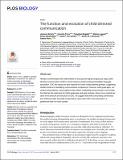Files in this item
The function and evolution of child-directed communication
Item metadata
| dc.contributor.author | Schick, Johanna | |
| dc.contributor.author | Fryns, Caroline | |
| dc.contributor.author | Wegdell, Franziska | |
| dc.contributor.author | Laporte, Marion | |
| dc.contributor.author | Zuberbühler, Klaus | |
| dc.contributor.author | van Schaik, Carel P. | |
| dc.contributor.author | Townsend, Simon W. | |
| dc.contributor.author | Stoll, Sabine | |
| dc.date.accessioned | 2022-09-14T17:30:05Z | |
| dc.date.available | 2022-09-14T17:30:05Z | |
| dc.date.issued | 2022-05-06 | |
| dc.identifier | 281291264 | |
| dc.identifier | 02b0d569-e68e-40e4-8f8b-8fe0b6201792 | |
| dc.identifier | 85130340905 | |
| dc.identifier | 000836908300007 | |
| dc.identifier.citation | Schick , J , Fryns , C , Wegdell , F , Laporte , M , Zuberbühler , K , van Schaik , C P , Townsend , S W & Stoll , S 2022 , ' The function and evolution of child-directed communication ' , PLoS Biology , vol. 20 , no. 5 . https://doi.org/10.1371/journal.pbio.3001630 | en |
| dc.identifier.issn | 1544-9173 | |
| dc.identifier.other | ORCID: /0000-0001-8378-088X/work/119212146 | |
| dc.identifier.uri | https://hdl.handle.net/10023/26018 | |
| dc.description | Funding: Writing this article was supported by the National Centre of Competence in Research (NCCR) Evolving Language, Swiss National Science Foundation Agreement 51NF40 180888 for JS, CF, FW, KZ, CPvS, SWT and SS. SWT was additionally funded by Swiss National Science Foundation grant PP00P3_198912. | en |
| dc.description.abstract | Humans communicate with small children in unusual and highly conspicuous ways (child- directed communication (CDC)), which enhance social bonding and facilitate language acquisition. CDC-like inputs are also reported for some vocally learning animals, suggesting similar functions in facilitating communicative competence. However, adult great apes, our closest living relatives, rarely signal to their infants, implicating communication surrounding the infant as the main input for infant great apes and early humans. Given cross-cultural variation in the amount and structure of CDC, we suggest that child-surrounding communication (CSC) provides essential compensatory input when CDC is less prevalent—a paramount topic for future studies. | |
| dc.format.extent | 17 | |
| dc.format.extent | 1000455 | |
| dc.language.iso | eng | |
| dc.relation.ispartof | PLoS Biology | en |
| dc.subject | BF Psychology | en |
| dc.subject | T-NDAS | en |
| dc.subject | NIS | en |
| dc.subject.lcc | BF | en |
| dc.title | The function and evolution of child-directed communication | en |
| dc.type | Journal article | en |
| dc.contributor.institution | University of St Andrews. Institute of Behavioural and Neural Sciences | en |
| dc.contributor.institution | University of St Andrews. Centre for Social Learning & Cognitive Evolution | en |
| dc.contributor.institution | University of St Andrews. School of Psychology and Neuroscience | en |
| dc.identifier.doi | https://doi.org/10.1371/journal.pbio.3001630 | |
| dc.description.status | Non peer reviewed | en |
This item appears in the following Collection(s)
Items in the St Andrews Research Repository are protected by copyright, with all rights reserved, unless otherwise indicated.

